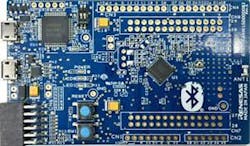Download this article in PDF format.
It wasn’t too long ago that a 32-bit microcontroller was an exotic device. Today, these micros are generally commonplace and affordable. The latest generation of 32-bit devices have been substantially improved, and they’re supplied by multiple competitive vendors. Some semiconductor manufacturers have even customized these devices for selected application areas. That’s what Renesas did with its new line of MCUs.
Sponsored Resources:
- Easy to develop IoT edge devices with embedded artificial intelligence
- RA4W1 RA Family MCUs
- Evaluation Kits for Renesas Advanced Microcontrollers
Renesas RA MCUs
The Renesas RA embedded microcontrollers are based on the Arm Cortex-M CPU cores, including the Arm Cortex-M4 and -M23. Multiple versions exist with a wide range of flash (256 kB to 2 MB) and SRAM choices. Package options extend from a small 32-pin device to a large 176-pin version. Interfaces include USB, CAN, and Ethernet, plus most of the other popular serial I/O ports. Other highlights are a Secure Crypto engine, a 24-bit analog-to-digital converter (ADC), Renesas’ human-machine interface (HMI) capacitive-touch technology, and controllers for TFT LCDs.
The RA MCUs are flexible enough to cover an extensive range of applications. Almost any Industry 4.0 building, or factory-automation use case, is covered. Home applications focus on white goods, healthcare, and metering. If wireless connectivity is required, a model is available to address that need.
Wireless Connectivity Option
A special version of the RA family is the RA4W1 that integrates Bluetooth 5.0 Low Energy (see figure). The chip, which implements the Arm Cortex-M4 core, has been optimized for low power consumption: 3.3-mA receive, and 4.5-mA transmit. With Bluetooth’s (BT) mesh capability, wireless sensor networks can be accommodated.
BT radios can achieve a data rate of 2 Mb/s, but its best receive sensitivity is −105 dBm at 125 kb/s, significantly extending the range. The MCU includes the Bluetooth (BT) protocol stack plus several API functions that support standard profiles like the Heart Rate Profile, Environment Sensing Profile, and the Automation I/O Profile. These profiles greatly reduce development time and costs.
Further BOM cost reduction is achieved by integrating some circuits typically implemented outside the chip. Examples are an on-chip oscillator and an adjustment circuit plus LC network for antenna matching.
This version of the RA MCUs runs at 48 MHz and features 512 kB of flash and 96 kB of SRAM. Interfaces include USB, CAN, and Renesas’ HMI capacitive-touch technology. A major feature is the Renesas Secure Crypto Engine to implement strong security of IoT applications. The package is a 7- x 7-mm, 56-pin QFN.
Keep in mind that Renesas also offers a wide range of evaluation kits for all RA MCUs. These will get your next embedded project off to a fast start. The development boards provide serial I/O connectivity for debugging and access to an MCU I/O pins.
The Software that Makes the Hardware Irresistible
The thing that makes this line of 32-bit MCUs so attractive is the developmental software that supports it. Called the Flexible Software Package (FSP), this development package is an enhanced version of the original design that included some basic Arm development software. The usual development tools include an IDE, compilers, libraries, and debuggers. Also in the mix is Arm’s ecosystem of third-party solutions. FSP comes with FreeRTOS that can be replaced with another RTOS or some middleware as required by the application.
The key highlights of the FSP are the AI enhancements. These enable the creation of solutions involving advanced neural networks, machine learning, and motor-control capabilities. More and more designers are adopting AI solutions and must have an MCU that supports the needed software.
As mentioned earlier, the on-chip crypto engine is supported by the FSP and adds enhancements to secure chip-to-cloud connections with all major cloud providers. Other features include secure key generation, encrypted key storage and support for hardware acceleration of AES, SHA-2, RSA 2K, NIST elliptic-curve crypto, and secured MQTT connections over TLS.
AI Apps Get an Improved MCU
Increasingly, designers are adopting artificial-intelligence approaches. And in some use cases, an AI solution is the only possible or practical solution. Renesas is addressing this need with its new RZ/V MCU series. The initial product, dubbed RZ/V2M, is made up of two Arm Cortex-A53 cores operating at 1 GHz. Called a dynamically reconfigurable processor (DRP), it’s optimized for AI acceleration. This device is designed to provide real-time AI inference capability while achieving excellent power efficiency.
An interesting feature is an imaging signal processor (ISP) that can process high-definition 4K video at 30 frames per second (fps). One target application is face detection and recognition. The device includes an H.265/H.264 encoder/decoder, too. Support for CMOS sensor interfaces and two simultaneous cameras is provided. The RZ/V2M also includes support for USB3.1, PCI-E, and Gigabit Ethernet interfaces and both MIPI-DSI and HDMI display interfaces. Power consumption is about 4 W.
Partner Solutions
Another good reason to consider Renesas’ 32-bit MCUs is its partner solutions. The company has teamed up with over 30 companies who can deliver a variety of solutions that work “right out of the box.” Most of the available solutions are for the IoT endpoint and edge applications. Your design objective may have already been developed. For more details, check out www.renesas.com/ra-partners.
Summing Up
The Renesas 32-bit MCUs are eclectic contemporary processors optimized for the times. If you’re moving more toward AI solutions, these devices are certainly worth evaluating.
Sponsored Resources:
- Easy to develop IoT edge devices with embedded artificial intelligence
- RA4W1 RA Family MCUs
- Evaluation Kits for Renesas Advanced Microcontrollers
Related Resource:

